After working with dozens of companies over the last 2 years, we’ve found that almost all of the companies we’ve worked with didn’t have a clear understanding of their customer before conducting customer research.
For example…
- One company thought they were targeting startups and enterprise companies, and after conducting user research, they realized that startups were actually horrible customers for their product.
- Another company realized that they had no clear competitive advantage and they completely shifted their positioning in a new direction (and might even create a new product to go after their new found opportunity).
- More than one company has come to us wanting to sell development or design services but has a blog full of content for developers or designers (who are their competitors, not customers).
We’ve found that user research has been the missing link for many of these companies to dramatically improve their marketing, and not just content marketing, but marketing as a whole.
In my recent post “You Don’t Know Your Customer and It’s Crippling Your Growth”, I showed companies how they can conduct a user research survey with their customer base to gain qualitative feedback about their product or service.
In this post, I’m going to show you what you can learn from that simple survey to your customer base. I’m going to share the questions we asked our customers, share what we wanted to learn from each question, and then share what did learn through our customer’s answers.
In my next post, I’m going to share how to turn these learnings into actionable growth ideas.
Let’s dive in.
How many responses do you need to gain valuable insight?
Before I dive into the questions and results that came from our survey, I know this question is going to come up:
“How many responses should we shoot for to get enough insight about our customer base?”
The best answer is: the more the better.
You don’t need a ton of responses to start getting learnings and start seeing clear patterns in the responses (as you’ll see from our results below).
For us, after receiving 32 responses we decided not to resend the survey to our list because there were some clear insights in the open responses.
We also do extensive customer research through our welcome email, talking to our customers on the phone, through our customers from content coaching and from the beta version of our content marketing training program – therefore we have a good pulse on our audience.
How To Interpret Your User Research Survey – What We Wanted To Know About Our Audience and What We Learned
As you’ll notice from the questions we asked, they didn’t exactly mimic the same questions outlined in my previous post. We had very specific things that we wanted to get a better understanding of, so we tweaked the questions to learn key insights about our business.
Below, I’ll state the question that we asked, tell you what we intended to learn from that question and then share what we actually learned.
Demographics – Getting A Better Understanding of Who Our Audience Is
Question 1: What Is Your Job Title?
What did we intend to learn by asking this question?
From the very beginning of our business, we set out on a goal to build an audience of marketers that work inside of companies -for example: CMOs, VPs of Marketing, Content Marketing Managers, etc. The intention behind the question above was to find out how well we’ve been executing on that goal.
Through our content and promotion strategy, have we been able to attract the right people in our target audience? Or are we attracting a bunch of people that don’t match our goals.
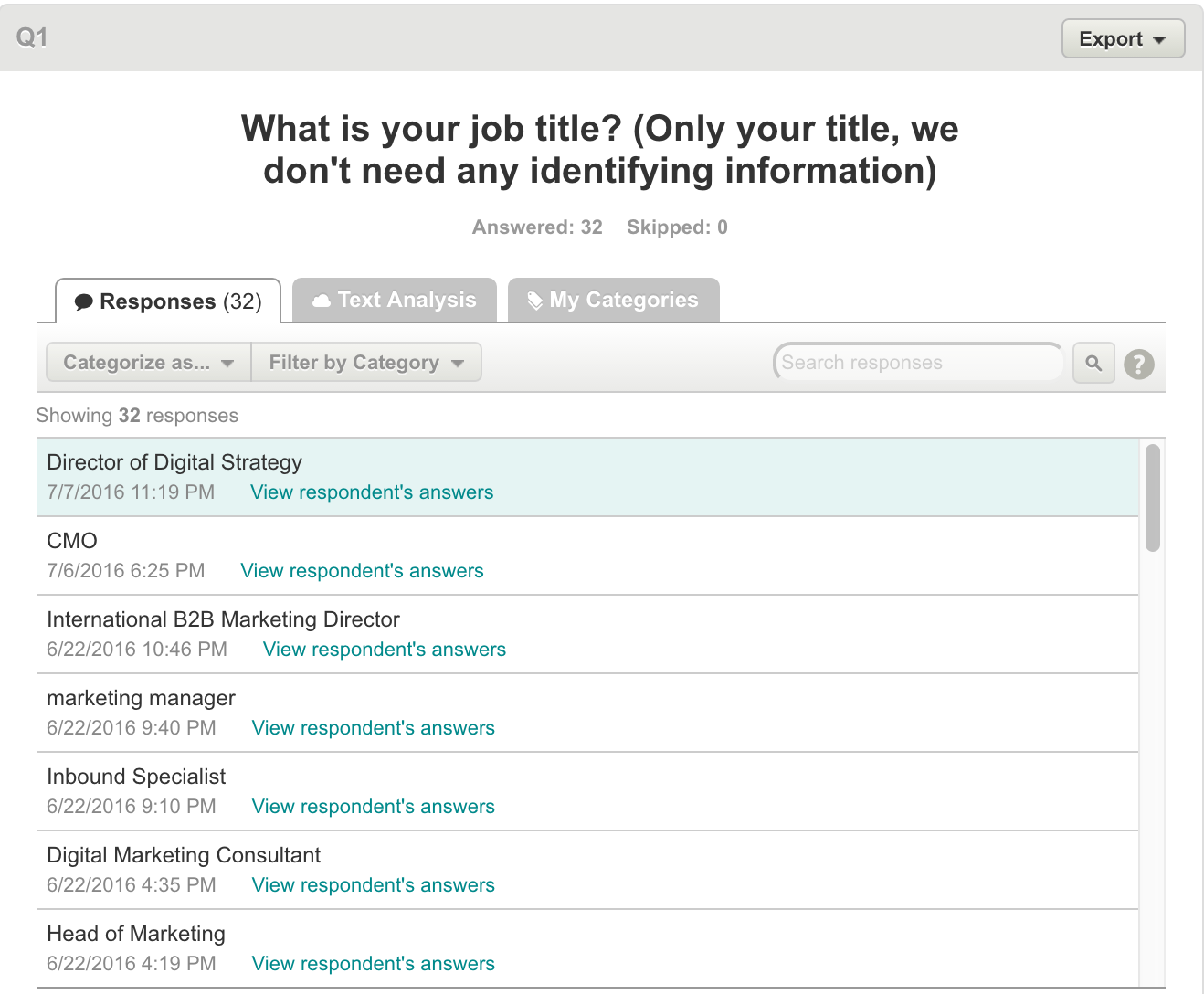
The Results:
75% of our respondents had CMO, Marketing Director, Manager, Coordinator or Specialist titles.
15% of our respondents had CEO, President or Founder titles.
5% of our respondents had other titles.
What Did We Learn?
It validated our hypothesis that our audience is mostly made up of marketers inside of companies. Only a few of our respondents were outside of our direct target audience.
We’ve been trying to write content that is specifically for marketers that work at companies and we’ve been using certain promotional channels to get in front of them. So it also told us that we’re on the right track from a content strategy and promotion perspective.
Question 2: What Type of Business Do You Work For?
There are a few of things that we wanted to learn by asking this question:
- What types of businesses are finding our content most useful?
- What types of business case studies should we focus on?
- What type of content should we write more about?
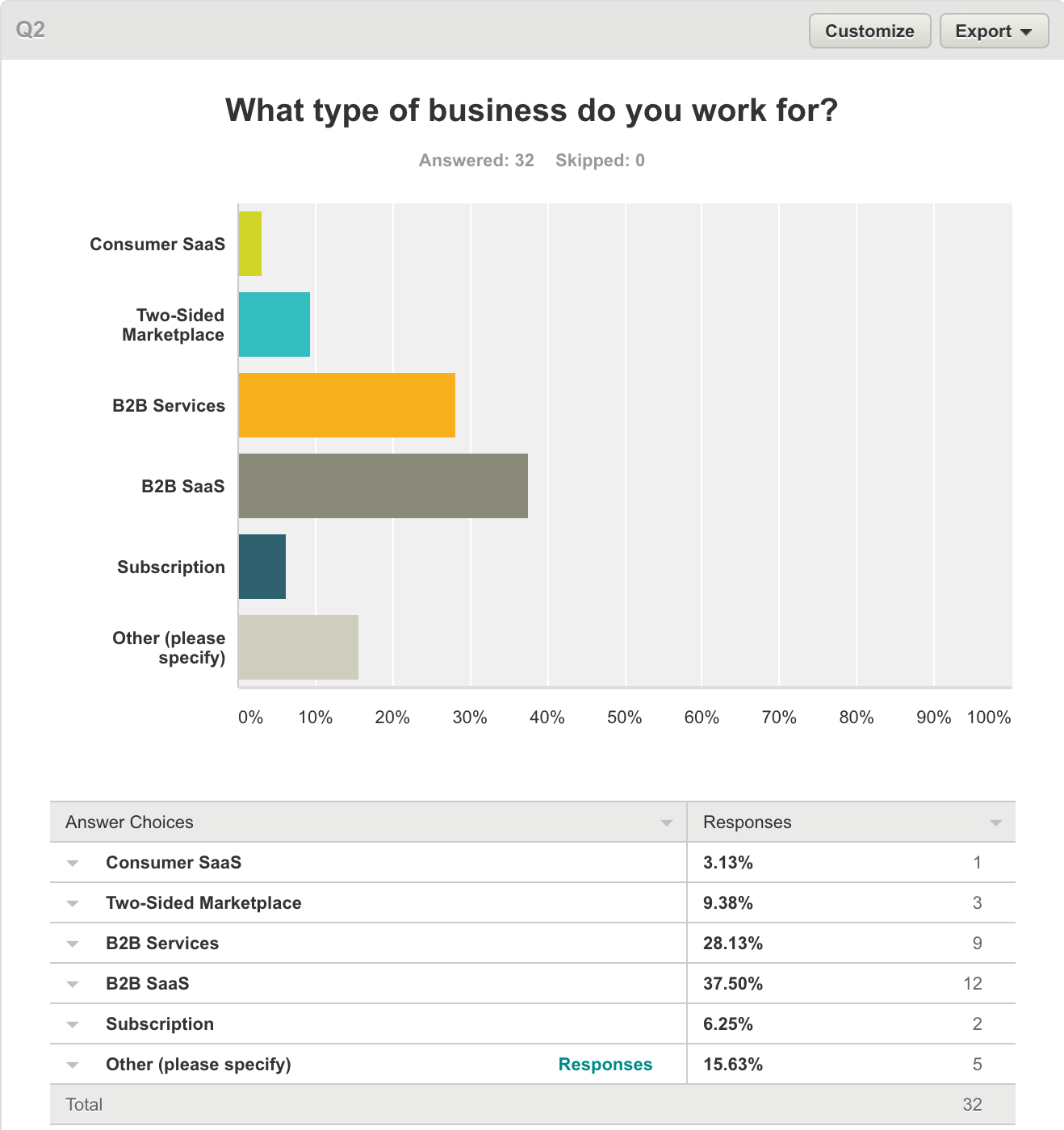
Results:
- 65+% fall into the B2B services of B2B SaaS
- The rest is spread fairly evenly amongst the rest
What did we learn?
B2B businesses make up a majority of the audience on our blog.
We can interpret this in two different ways:
- We could create more content that helps out B2B businesses as that seems to be the majority of our audience. Then we could use that content to expand our reach to more B2B businesses.
- Bring in more examples for different types of businesses to expand our reach to businesses outside of the B2B audience.
In this case, we haven’t set out to attract businesses from a particular vertical. So we’ll probably do a mix of 1 and 2, knowing full well that who we have on our list is largely a function of what examples we use and where we promote.
Getting A Better Understanding of Where Our Audiences Comes From And Why They Visit Our Site
Question 3: How Did You First Hear About Us?
With this question we were trying to learn what’s working from a content promotion perspective and where to focus more of our time. Content promotion is very time intensive, and if we can narrow in on what’s driving a majority of our visitors, we can come up with new ways to further penetrate those channels.
Obviously, these results should be (and are) coupled with Google Analytics data.
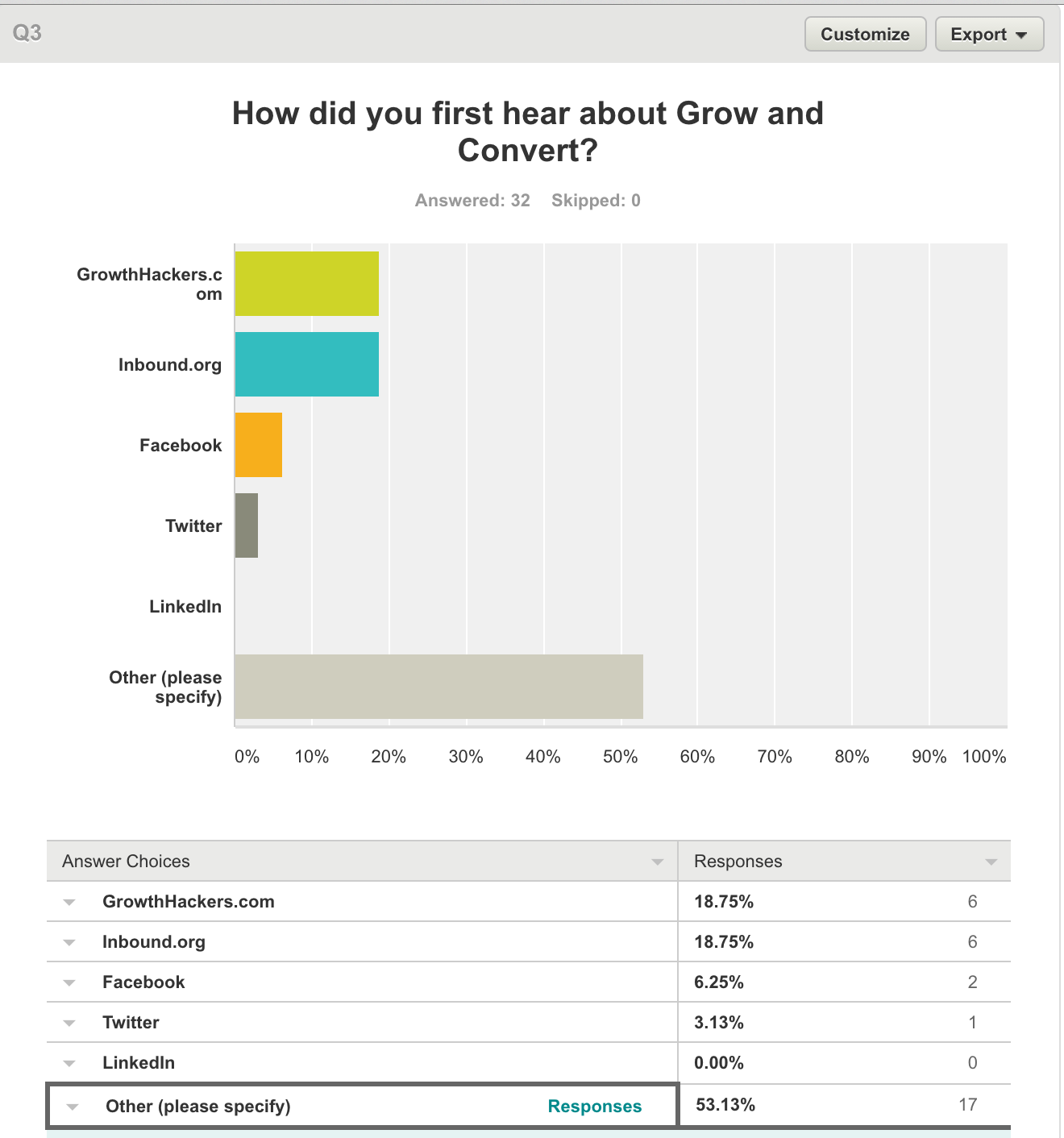
The Results:
50+% said other
- 7 found us through a mention on another site
- 4 were referred to our site by a friend (Awesome!)
- 3 Google (Yay! SEO is starting to work)
- 3 don’t remember
GrowthHackers and Inbound were even
Facebook, Twitter and LinkedIn were minimal
What Did We Learn?
For this specific question, we’d have to have more data to rule out that a channel like LinkedIn isn’t effective for us.
But what’s interesting for us is that there were a high level of people that found us through another website… this we wouldn’t have expected.
This might mean we should focus more time on guest posting, being on podcasts, and sending in quotes for roundup posts on other sites. What we’re happiest about is that people are finding out about us through friends (thanks for sharing guys!). For a website, it’s a good indication when you start getting word of mouth visitors – people are talking about us in marketing circles.
Lastly, GOOGLE!
It’s been a big initiative for us to start focusing on SEO, so good to see that some of our efforts are starting to kick in.
Overall, we would’ve thought that a majority of our visibility is coming from GrowthHackers and Inbound but it’s good to see how many people are finding us in other ways.
Question 4: What Is The Biggest Challenge You Currently Face In Your Role?
This is where it starts to get fun. We’re moving from basic demographic info to getting inside the users’ minds.
With this question we were aiming to find out people’s pain points. This will help us come up with ideas for blog posts, help steer our product roadmap and better understand the motivations of our target audience.
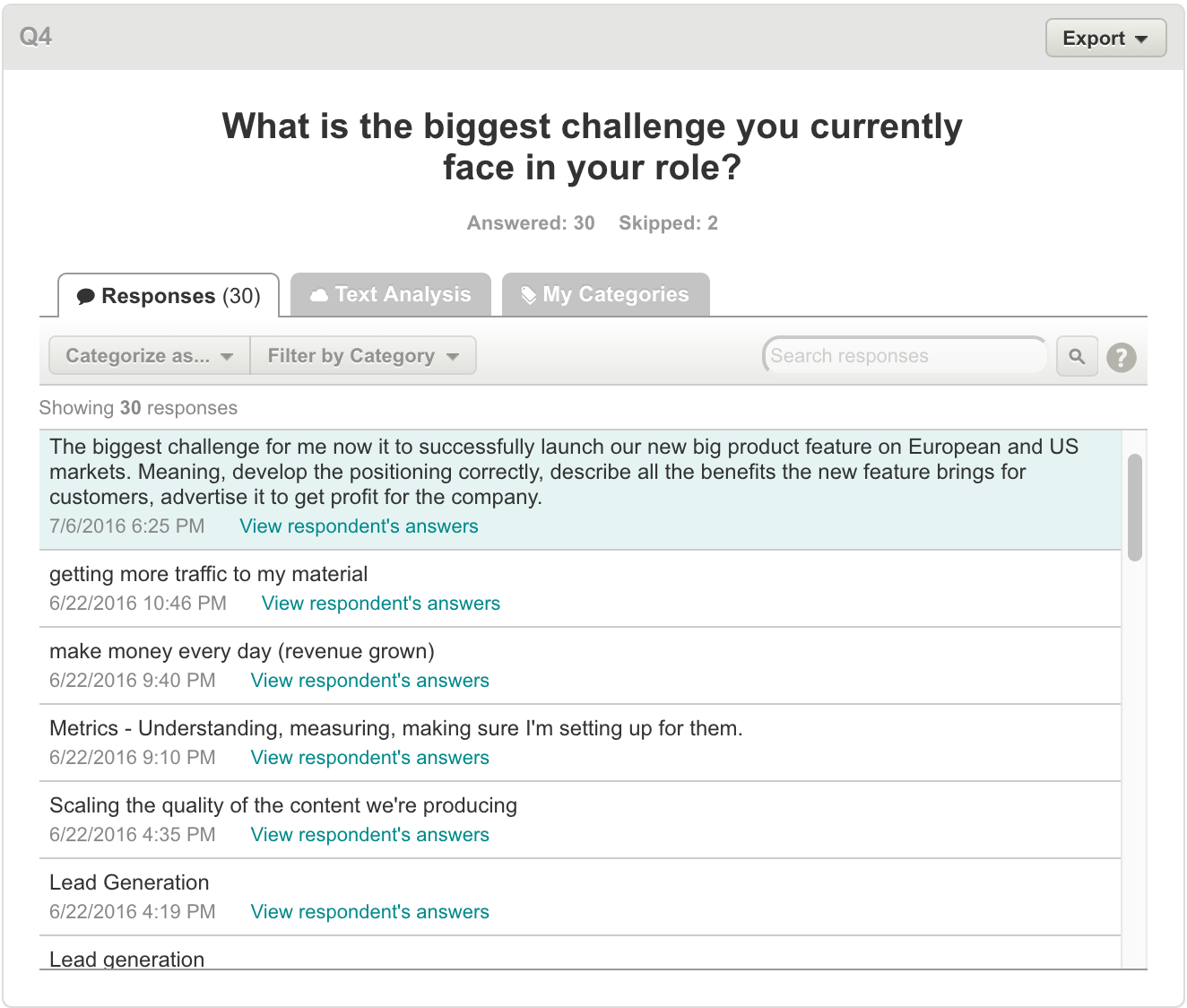
The top challenges that marketers face (below were common themes from the answers):
– “Scaling the quality of posts and writing posts that don’t say the exact same thing as everyone else.”
– “Developing positioning and messaging”
– “Lead Generation and driving high quality leads to the company”
-“Getting more traffic”
– “Strategy, Defining our target audience”
– “Metrics, understanding, measuring and setting them up”
What We Learned:
The answers above helped inform some of the things that we cover in our training program and in our blog posts. For example, relating to content quality, we launched the post: The specificity strategy: How to Turn Generic Posts into Stand Out Content last week.
We realized we should focus more on lead generation ideas (the next post) and improving lead quality. Also, helping marketers understand what KPIs to report on and how to talk to their managers about metrics.
We use the answers from this question to steer our content strategy and product development.
Question 5: Has Grow and Convert Made an Impact On Your Business?
When we set out to create Grow and Convert, we didn’t want to become “just another marketing company that gives generic advice”. We really wanted to focus on quality content that helps marketers excel at their jobs.
This question was important to validate that our content is actually useful to companies that read our blog.
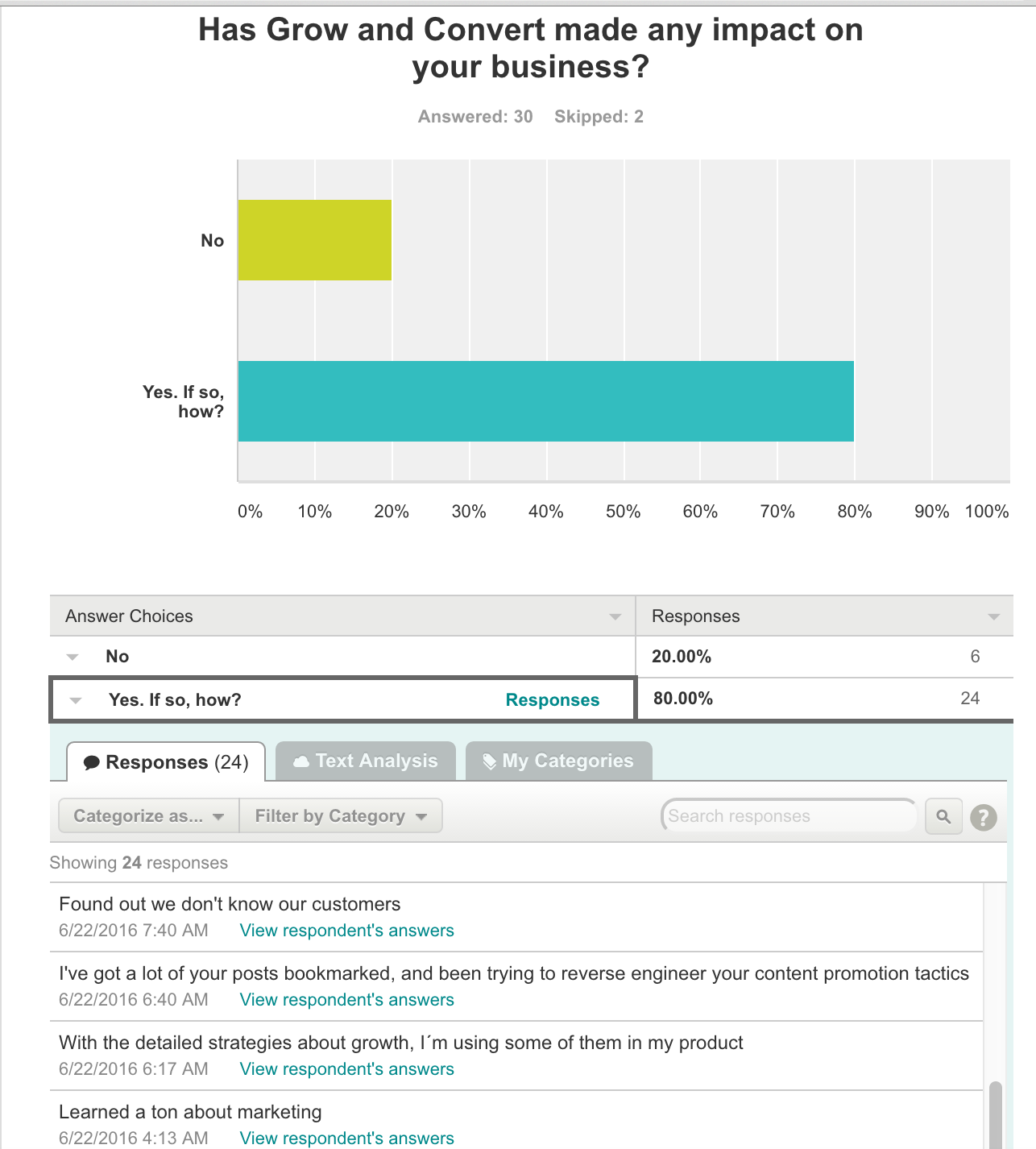
Results:
80% of people said that Grow and Convert has helped them in their business.
How have we helped our audience?
– “Knowing I’m not alone in my struggles”
– “it has impacted the way I look at my numbers”
– “It has verified things that I’ve been suspecting for a while and helped me convince my bosses to go in those ways”
– “I learned how to do content marketing based on communities”
– “Found out we don’t know our customers”
– “Survey idea really helped, product/market fit, customer focus, etc.”
– “It’s forcing me to work on the business and not in it”
– “Inspiration and examples”
– “impact on my thinking, and thus on the way I work day in & out”
What did we learn?
That it’s important for us to relate to other people’s challenges. By knowing our customer in depth, we’re able to provide better content to them and relate to them in ways other blogs don’t.
Also, that by sharing real examples of what we’re doing, it’s helping people learn how to apply complex marketing concepts to their business.
We make people think about their business in a different way… In the next post we’ll show you how we turned this feedback into a growth idea for our business.
Question 6. What is the main benefit of Grow and Convert?
Now, on top of just trying to out if we provide value to our audience, we wanted to figure out where the value is derived from. We wanted to find out what we’re doing well and what our audience thinks the most valuable thing is about our business.
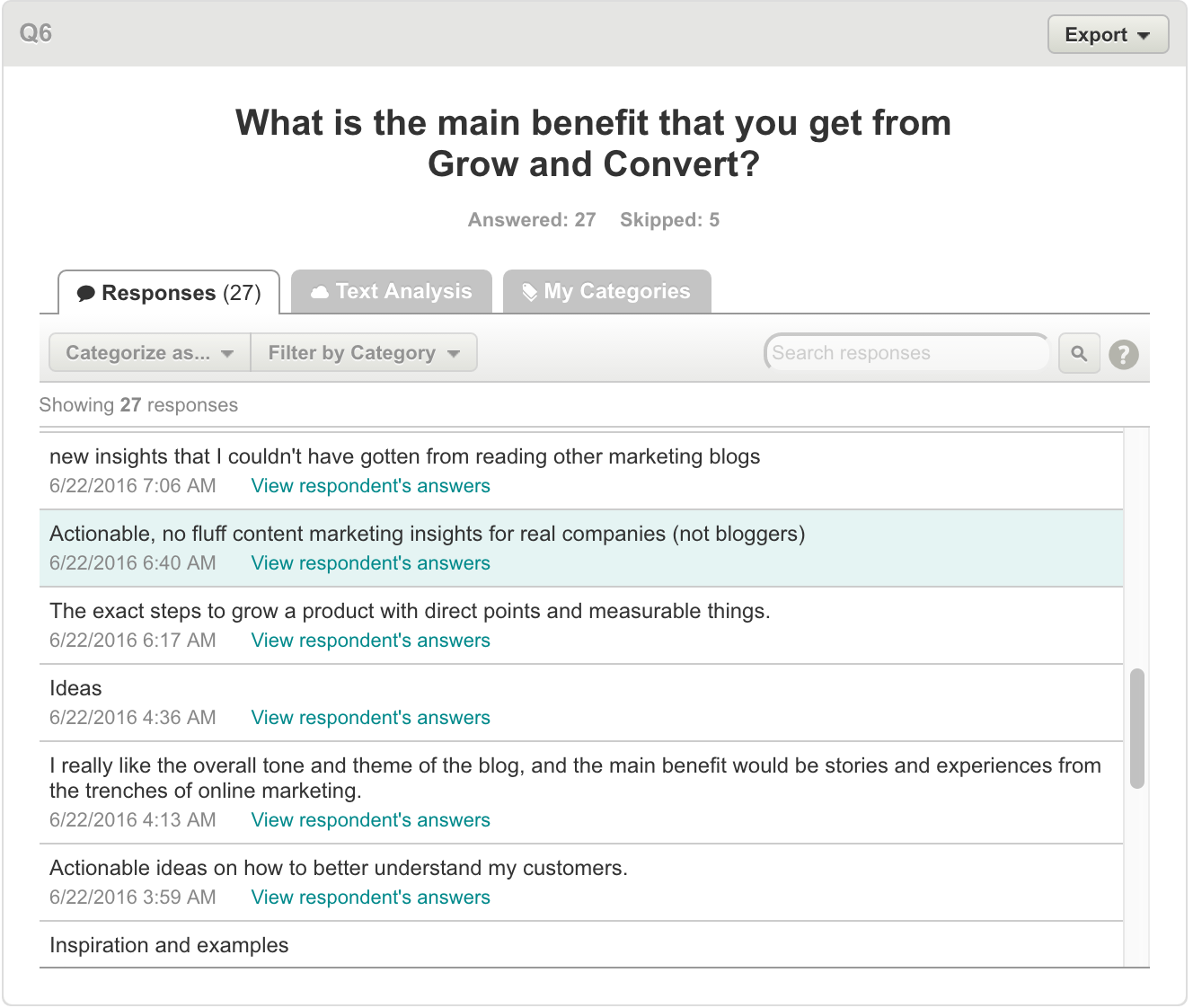
What were the main themes from the responses?
- People love the “actionable ideas”
- People love the “step by step process”
- People love the “transparency and honesty”
- People love the “great topics”
- People love that it’s “straight to the point, no bullshit”
- People love that they’re able to “take what I read and apply it – which so many blogs lack”
What did we learn?
It’s really interesting to hear how people think of us. We had assumptions about we think we do well, but it’s validating to hear where other people say they get value. We learned, what really separates our site from others, is the level of detail on specific subjects, the full transparency and the real world examples.
Question 7: What makes Grow and Convert different than the competition?
Now you might think that this question is very similar to the main benefit that people would get from our site. But we thought it was important to hear how people compared us to the competition and why people felt that we were different. Again, we were starting a marketing blog in a competitive landscape and we really needed to know why people felt we were different to double down on those key points.
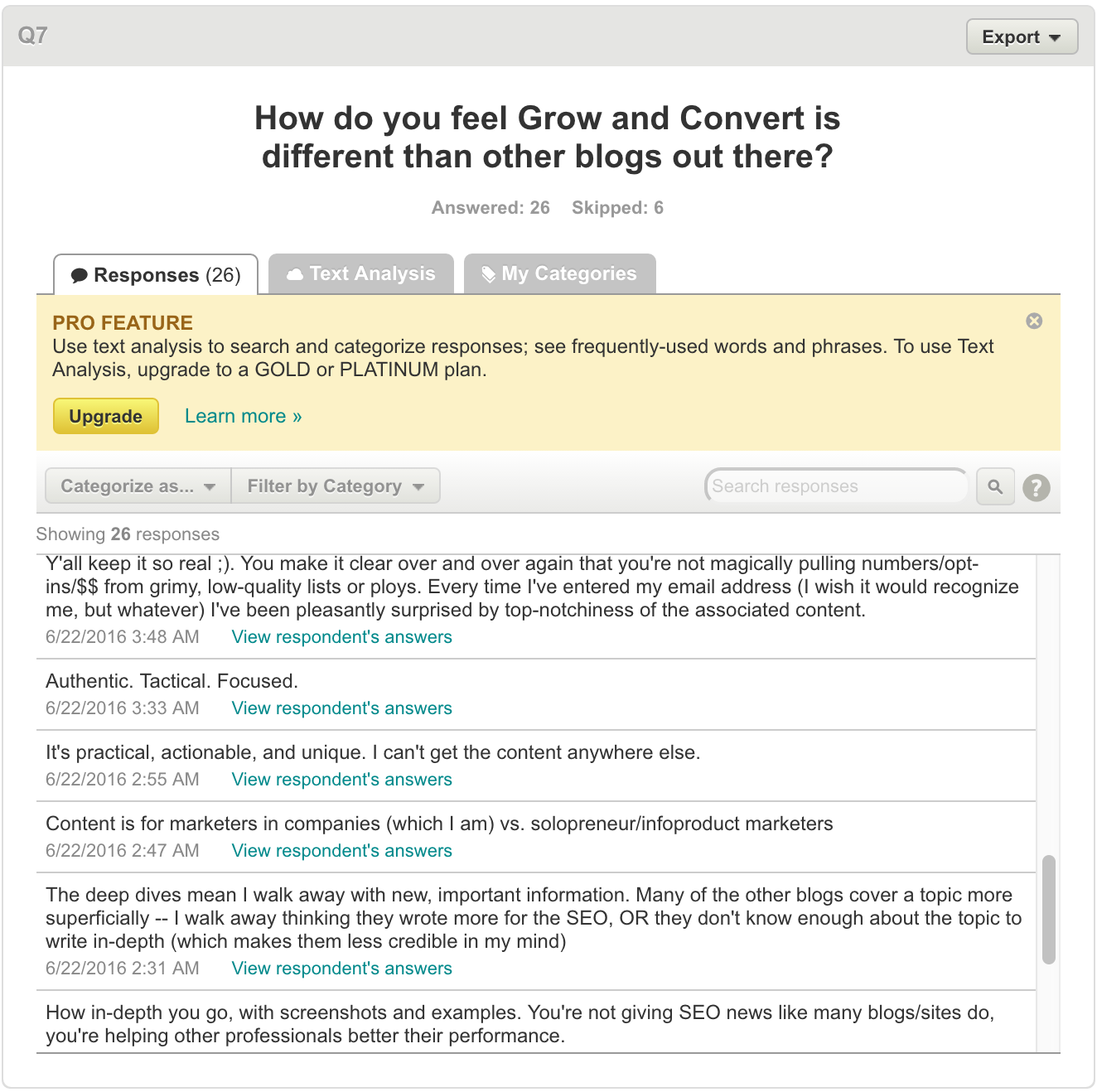
Results:
– “Honest, transparent, and unique content” – many times
– “You actually show us what you did and not just tell us to do it. That’s huge.”
– “There is something about your language that is VERY relaxed, yet confident. Also, many other blogs wouldn’t give this much info out, especially about your experiments that didn’t go as planned.”
– “The content is not a rehash but from a point of view of what you’ve experienced- case study.”
– “It’s relatable, has a good tone, less polished compared to other blogs, which is a good thing.”
What Did We Learn?
In other words, we learned what our competitive advantage is in our customer’s point of view. This helps us narrow in on what we do well and provide more of it.
A key theme we’re noticing here is that we are successfully embodying authenticity, honesty, transparency, and showing examples instead of just giving high level platitudes. Those that have been following us from the beginning know that’s the basis upon which we started this company.
We sought to be different by writing from real world experience vs. sharing high level theory. We saw that most companies are scared of giving away information, but by doing so, we can help our audience learn more and connect with them on a deeper level.
Question 8: What marketing blogs do you read frequently?
Now that we know how we compare to our competitors, we wanted to know who our “competitors” are in our customers mind. I put competitors in quotes because many of these blogs are not truly competitors in a business sense but more competitors in a sense that we compete for our audiences time when it comes to consuming content.
By knowing what other blogs our audience reads, we will also know where to go to get in front of more people when it comes to expanding our reach.
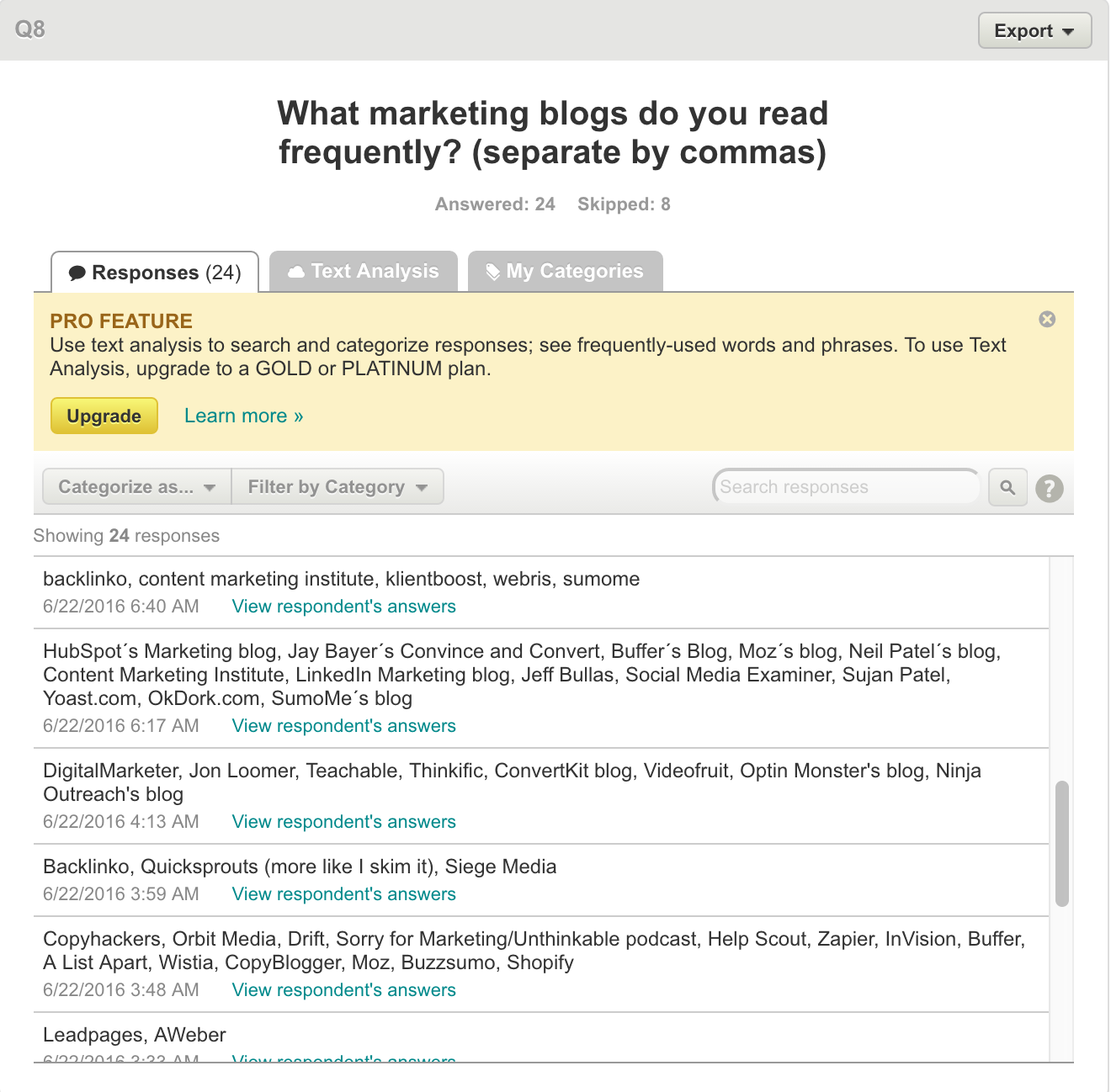
Results (mentioned more than once):
Moz, Copyhackers, Buffer, Coschedule, CMI, Search Engine Land, Marketing Profs, Kissmetrics blog, Intercom’s blog, OkDork, SumoMe, Andrew Chen, Hubspot, Convince and Convert, Backlinko, GrooveHQ, Hiten Shah, Tomasz Tunguz, ConversionXL, CopyHackers, Drift
What Did We Learn?
We learned what other sites our audience finds valuable and we learned where to find more readers that would likely be in our target audience.
Chances are if our audience reads these blogs, then we can find more people in our target audience by tapping into these communities. These might be good places for us to guest blog post or might be good sites for us to explore relationships with.
Question 9. What communities are you a part of?
A big part of our promotion strategy is to share our content in various communities. This question was aimed at figuring out what communities our audience participates in.
We think that there are most likely communities we’re not aware of. Or that there might be communities we’re not participating in that could be good for us to find new potential customers.
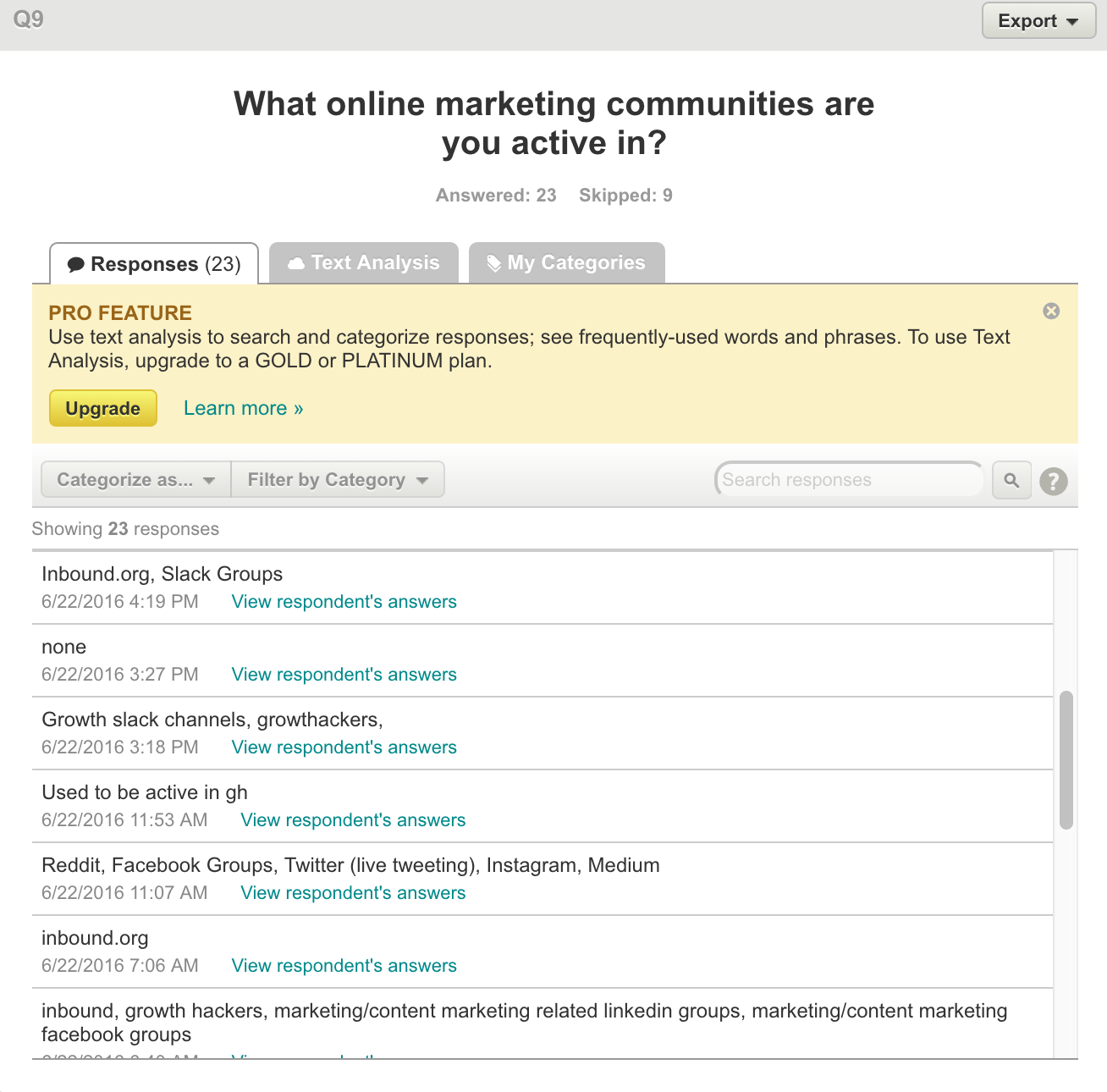
Results:
SEMPO, SMX, Inbound.org, Moz, Hubspot, Marketing Slack Groups, Reddit, Live Tweeting (there’s an idea), Product Hunt, Marketing LinkedIn Groups, CopyHackers, Quora, GrowthHackers…
What Did We Learn?
There were definitely some communities we’d never heard of SEMPO and SMX.
One of the respondents mentioned that they participate in live Tweeting – that’s an idea for us to try something new.
A couple of respondents mentioned they’re on Reddit – we’ve gone back and forth on if Reddit contains people in our target audience or not, this proves that it does and that we should try to retest distribution there.
So What Now?
If you haven’t yet, run a user research survey amongst your customer base.
If you have a blog, feel free to use these questions on your own user research survey to learn more about your audience, your competitive advantage and your competition.
If you have a product or service, use a combination of the questions from this post and the last post to understand the motivations behind your customer so you can come up with product improvements, acquisition and retention ideas.
In the next post we’re going to share how we translated these learnings into 7 actionable growth ideas. The growth ideas are aimed at improving our product, acquisition, engagement and retention.
Comments? Questions? Opinions? Please feel free to share in the comments below. We’ll respond 🙂
Get a link to our entire survey
Every question. Every answer.
This is a free bonus for our email newsletter subscribers. If you're not on our newsletter, just enter your email to join and we'll send the survey link. it's free and you can unsubscribe anytime.








